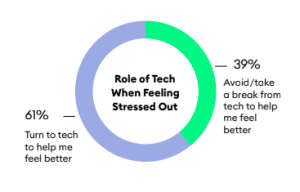The World Health Organization has declared mental illness the leading cause of disability, affecting more than 970 million people worldwide. Here in Canada, one in two Canadians struggle with mental illness before reaching 40, an alarming statistic released by the Center for Mental Health and Addiction. A lack of mental health resources and difficulty accessing such community resources further adds to this global problem. Furthermore, the loss of life due to mental illness, and the negative impact it has on quality of life, makes this an imperative issue to address, one that has only been further complicated by the global pandemic.
50% of young Canadians have expressed a need for better access to health resources in order to care for themselves properly and live a happy, healthy life. Another 31% reported that accessing material online is a step in their self-care strategy. This indicates that there is a clear opportunity for digital platforms to incite necessary social change.

Source: VICE Media and TELUS
In a recent panel by Harvard University, April Mims, Vice President of Public Policy from Hims and Hers, posited that, “Telehealth has so much promise. But unless we can make all these tools accessible to more people, we’re not going to fully deliver on the promise of telehealth.” The responsibility falls on leaders in technology to foster widespread accessibility of such digital resources.
While the negative effects of technology on mental health have also been researched and documented (e.g. reliance on technology potentially leading to feelings of isolation, experiences with bullying, or fluctuating self-image), there is an equal opposite truth: the manifestation of positive, supportive online spaces created to improve wellbeing. Through the provision of such technology, we can tap into a generation that is actively seeking digital avenues of support, ones that might offer more anonymity and convenience than in-person resources can. Whether that is a faceless interaction with a counsellor online, or a chat with an automated assistant about sensitive subjects (e.g. financial difficulty, illness), these non-judgmental environments provide fast and accessible tools for wellbeing.
In 2016, the BRIGHTEN study exemplified, through its qualitative and quantitative findings, how technology can be used to diagnose mental conditions, provide treatment, and conduct research through a single application. Additionally, the gaining popularity of mindfulness apps, online counsellors, and crisis text lines, further attests to the demand for accessible self-care platforms. As this demand rises, so does opportunity to provide support where it matters.
More businesses are digitizing every day, with greater potential to bridge the health and wellness gap through the provision of tailored information that resonates with younger generations. In these difficult times, the technology community must work to establish accessible tools for wellbeing. kama.ai is committed to researching and addressing the efficient delivery of community health and mental health resources; we believe our Designed Emotional Intelligence® has a role to play here. It is our goal to partner with the tech community, and with organizations and practitioners, to provide timely access to information and support for the overall betterment of society.
